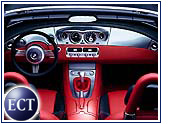
Driving is a time-consuming activity for many: Salespersons spend hours journeying from customer site to customer site; maintenance technicians weave through traffic as they go from office to office; and families spend time traveling to soccer games, relatives’ homes and school activities. Ideally, individuals would like to transform those treks from monotonous, time-consuming events into entertaining or useful exercises, a preference that soon might be realized.
Increasingly, automobile manufacturers are integrating mobile communications systems into their cars, and these devices have the potential to transform automobiles into yet another Internet data-delivery system. Once vehicles are outfitted with Internet access, passengers and drivers can exchange e-mail information, transfer completed trouble tickets to the home office and even download movies to entertain restless children.
Theoretically, these services, dubbed Internet telematics, have been available since the middle 1990s, but they have been deployed in significant numbers only during the last few years. The initial focus has been using computer technology to enhance automotive safety and ease driving hassles. Onstar (a subsidiary of General Motors) and ATX Technologies (which provides telematics services to Mercedes Benz) are two companies that offer such services.
Turn Right or Left?
“By delivering a needed customer service, automobile manufacturers view telematics as a way to enhance brand loyalty,” said Frank Viquez, research director for automotive research at market research firm ABI Research. Onstar has been particularly aggressive in promoting its service’s benefits by regularly running advertisements from customers who have used it during inconvenient or life-threatening situations.
Auto manufacturers have concentrated on helping drivers navigate through unfamiliar terrain, such as the route vacationers must take from the airport to the hotel. Vehicle maintenance has been another area of concentration, and here the systems monitor vehicle use and notify consumers when repairs are needed. Traffic report information also has started to gain traction.
There have been a few nonvehicle-based applications deployed. For example, the government has mandated that law enforcement officials and safety organizations use the technology to enhance 911 services. “Policemen in the San Diego Sheriff’s Department rely on Internet telematics to file their reports, and it allows them to spend more time on the road and less at their desks,” said Will Strauss, president of Forward Concepts, a market research firm.
Nonvehicle services, such as the delivery of e-mail or Internet entertainment, have been slower to take hold. “Some vendors underestimated the technical and marketing challenges they would face in transforming Internet telematics into a mass market,” Forward Concepts’ Strauss told TechNewsWorld.
Hands on The Wheel
Because automobiles present unique deployment issues, one hurdle stems from the challenge in building the receiving equipment. The receiving device might be exposed to fiercer elements — possibly being banged about as a person loads a heavy item into a car — and higher temperatures than PCs and handhelds typically encounter.
Manipulating the system can become a problem because a driver has to keep his or her hands on the wheel and eyes on the road, lest the driver end up in a heap along the side of a road. In response, manufacturers have been building receiving devices for automobiles or designing special extensions to cellular phones. Typically, these systems include voice-recognition technology that lets a driver speak into the system and text-recognition software that lets the system read computer-generated text back to the driver.
Network connections have presented another challenge, and three wireless options have emerged as potential solutions. Many of the systems now rely on satellite communications, which cover a larger territory than alternatives but can be expensive and open to interference. Cellular networks present another possibility, but their coverage range — as well as their bandwidth, at a few hundred kilobits per second — tends to be limited. Bluetooth links deliver more bandwidth — closer to 1 Mbps — but have not been widely adopted, especially in the United States. WiFi LANs offer plenty of bandwidth but have short transmission ranges.
A Tough Sell
Convincing consumers to pay for telematics services also has been a challenge. At the time of a new car purchase, automobile manufacturers either bundle the services with the car or offer them for an additional charge of, say, US$50 or so. In either case, the consumer usually receives a year or two of service and afterward must pay a monthly fee ranging from $15 to $75.
“The renewal rates with telematics services have been too low, less than 50 percent, to sustain a successful business model,” said Forward Concepts’ Strauss. Consumers might already carry cellular phones or have access to roadside assistance, and therefore might not want to suffer an additional, overlapping expense.
The vendors hope that by adding new content and services, such as e-mail, their services will become more appealing. “Car manufacturers, especially at the high end, are under a lot of pressure to differentiate their products, and that will continue to drive them to experiment with various telematics business models,” concluded ABI Research’s Viquez. “Eventually, they will sort out the technical and marketing issues, so use of these applications will become widespread.”





















































